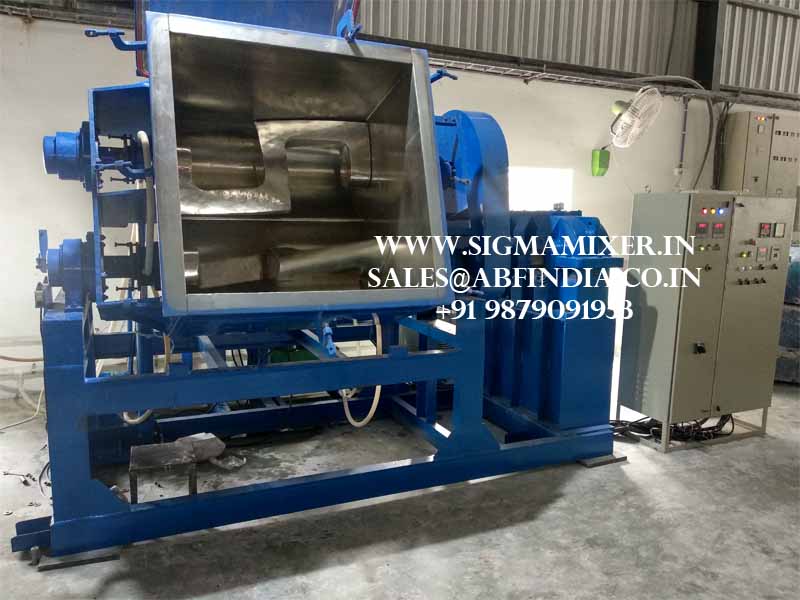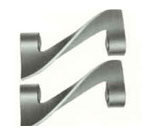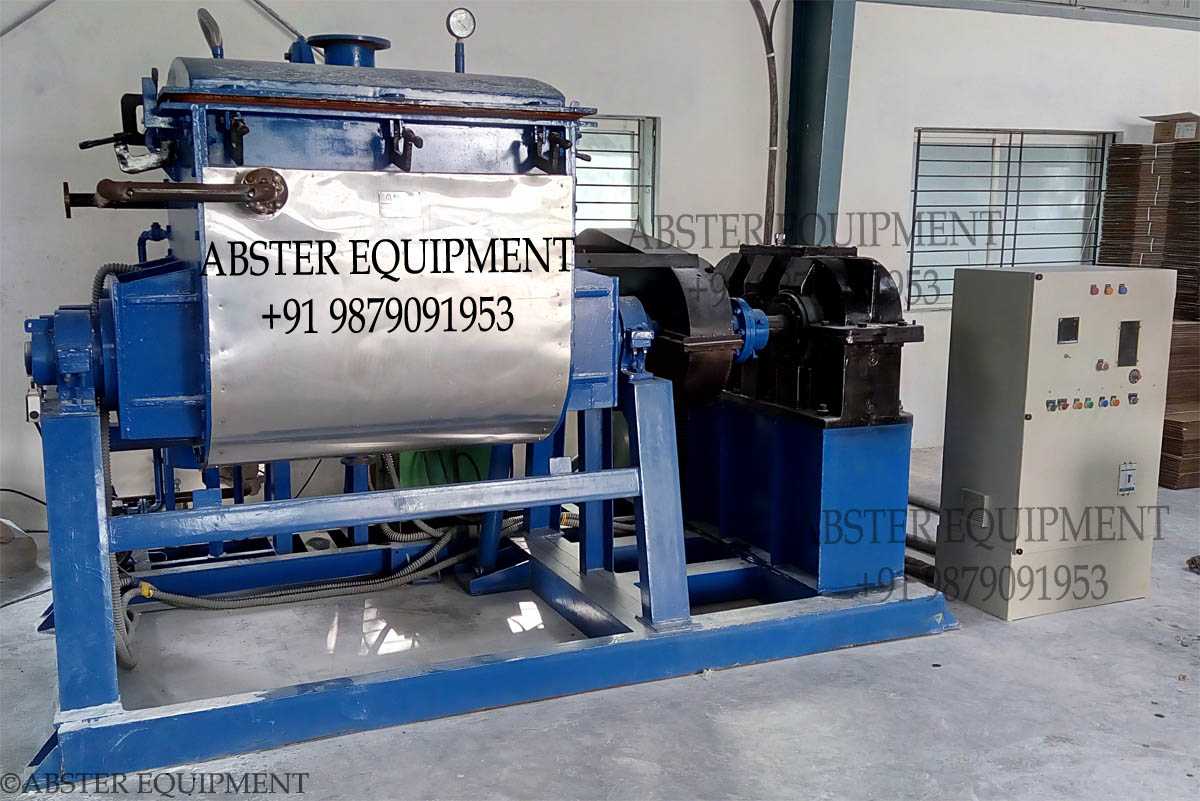
Sigma Mixer is highly popular equipment used for efficiently mixing and kneading high viscosity materials with utmost ease. Since, sigma mixer comes from the double arm kneader mixer family. So, let's take a quick look at the design and construction of double arm kneader mixers.
Double arm kneader mixers consist of two mixing blades which are positioned in a horizontal W shape. There is a wide array of blades made available such as masticator blade, sigma blade, spiral blade and nabbed blade to name a few. The gyratory motion of these blades takes place in two ways. One is peripheral motion to each other and the one other in which the blades inside the furrow can stretch outwards. The blades may operate at the same or different speeds while moving towards each other. The blades go over the container walls and each other at very close clearances of 2-3 mm which helps produce a homogenous mix. The biggest benefit of such close clearances is high shearing action which easily reduces every single large size particle. A consistent particle size distribution can be achieved within a very short span of time which is as less as just 10 to 30 minutes. High homogeneity levels can be expected while using these mixers. You can expect upto 99 percent of homogeneity which is amazing in itself. These mixers also come with their variants such as double arm kneader mixer extruders and they are very much capable of handling highly viscous materials. Even materials with 10 million centiposes viscosity can be managed.
You must know that double arm kneader mixer's energy consumption is quite high as opposed to other mixer types. It could be in the range of 45 to 75 kw for per m3 of mixture. The most commonly used double arm kneader mixer is sigma blade mixer which is the most sought after on account of variegated reasons.
Supporting tangential and oblique movement is necessary for the chemical in mixers that manage acid based products. The geometry of sigma blade has been designed in such a way that it can draw, shear, knead, coarse as well as fold the glutinous mass of the material. It becomes capable of doing so because of the blade manipulate which is just next to the trough. It may interest you that the twist angle of the blade can be adjusted according to the kind of shear you are looking for.
Now, let's take a quick look at how sigma blade mixer operates. Material is loaded from the top of the container, but it is mostly just about 40 to 65 percent of the total volumetric capacity of the mixer. Heavy duty drive systems are in place to facilitate the rotation of blades. These systems comprise a gearbox, motor, gears and couplings.
Usually the tip speed of a sigma mixer is kept to 60 metres/minute. The mixing process may take place either at room temperate or controlled temperature conditions. Provision of jackets is there for the circulation of hot or cold media which comes in handy to maintain the required temperature.
You can also equip the mixer with a discharge arrangement. The most commonly seen discharge arrangement is tilting discharge. Tilting arrangement of the container is designed for manual, motor or hydraulically operated arrangement.
For materials containing lower viscosity, a bottom discharge valve can be facilitated on the trough. It is flush with a mixer trough to keep at bay any sort of dead or unmixed pockets of material.
Frankly speaking the list is pretty long. This mixer is considered quite ideal for sticky, gritty, and pasty slurries with high viscosity quotient. Here is a list of some of the many products which can be mixed in sigma mixer.
Hope you found the post useful. As a producer of high quality sigma mixer, we have an exclusive range for you. Check out our products section, now!
Apart from the sigma blades, we also offer sigma disperser blades
Different types of Sigma Blade Available
 |
 |
 |
|
Sigma- or Z-form blade
|
Two wing blade
|
Double naben
|
All double arm Sigma Blade kneader also called Z arm Sigma mixers are competent of with two mixing blades situated in a W-shaped horizontal furrow. A variety of blade shape have evolved, every of which is best suitable for a scrupulous type of compliance. The frequently use blade types are the spiral blade, masticator blade sigma blade, nabbed blade, and shredder blade. The gyratory motion of the blades is either peripheral to every other or the blades may extend beyond within the furrow. The blades exchange toward each other at the identical or discrepancy speeds. The blades go over the container walls and every one other at close clearances (2-3 mm) resulting in homogenous combination. The secluded clearances assemble of very high shear action thereby sinking any huge particle. These mixers produce a consistent spot size section with no the need for additional high speed chopper. Homogenous mixing is achieved within 10 to 30 minutes. Amalgamation homogeneity up to 99% and improved can be accomplish by means of the double arm kneader mixers. This blender and their difference are capable of usage substance with viscosities as high as 10 million centipoises. The power expenditure in double arm kneader blender is very high compare to other types of mixer and can variety from 45 to 75 KW/m3 of mix substance. The sigma blade mixer is the most frequently used type of double arm kneader mixer, and is finest suitable for all surrounding utilize
Sigma Blade Mixer
In mixers managing very viscous materials, it is essential to support both tangential and oblique motion of the substance. The geometry and profile of the sigma blade is intended such that the glutinous mass of substance is pull, shear, dense, knead, and fold by the exploit of the blade next to the walls of the mixer trough. The amount to which this happen depends on the exploit of the blades - peripheral or overlap and the ratio of the speed of replacement of the blades. The twist angle of the blade can be customized depending on the necessary shearing.
Tangential and Overlapping Blade Action
In the peripheral intend the blades swivel in the trough gathering imaginatively the front blade normally rotate earlier than the back blade more often than not in the ratio of 3:2. Peripheral blades are usually used for substance of superior viscosities such as adhesive, rubber compound, flush colours, dye, and pigment.
In the overlap plan, the blades extend beyond above the burden of the container. Due to the overlapping exploit it is essential that the qualified location of the two blades is unaffected, and as a consequence, both the blade swivel at the similar speed. Materials that flow freely or move stealthily down into the blade are varied using the overlap blade action. This intends offers an earlier exchange of material from one blade section of the mixer to the other. Overlapping blade action is used for supplies of lighter viscosities such as ointments, clay coating, carbon pastes, and creams. The overlapping blade manufacture a lower kneading and shear contrast to the peripheral blade act.

Operation of Sigma Blade Mixer
In process, substance is loaded from side to side the top of the container to characteristically 40 to 65 percent of the mixer's total volumetric capability. The replacement of the blades is through serious duty drive system characteristically consisting of a motor, gearbox, coupling, and gears. The tip haste of the sigma blender is normally incomplete to 60 metres per minute. Mixing may be approved out at ambient temperature or under unnatural temperature situation. The blender trough can be providing with jackets for transmission of hot or cold media to continue the obligatory temperature situation within the mixer. The release of the material from the blender container is also by leaning of the mixer or from side to side an extruder / screw positioned in the lower segment between the two trough compartments. The mixer may be capable of with some one of these free activities.
The orientated discharge understanding is mainly common. The tilting understanding of the container may be intended for physical process or may be developed using mechanical or hydraulic understanding. Materials of inferior thickness, the base free valve may be providing on the blender trough. Intend outline of the valve should be flush with the blender furrow to keep left from any dead or straight pockets of substance).
The extruder/screw release has a benefit that supplies can be straight discharge, extruded, in the obligatory shape or size for additional dispensation. In adding, the screw intends eliminate operative experience to hot materials if the integration process are approved out at high temperature and/or with supplies that are toxic in character.
Sigma Mixer Working Principle Function And Application For Industrial Use
Ribbon Blender Working Principle
High Speed Disperser Working Principle
Advantages of Plough Shear Mixer Over Ribbon Blenders
Sigma Mixer- Design & Construction Operations and Applications Explained
Copyright © 2025, Abster Equipment All Rights Reserved.